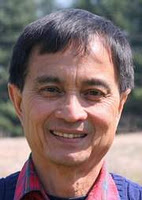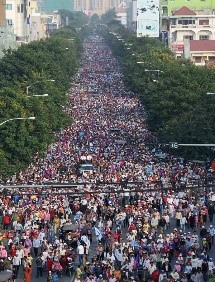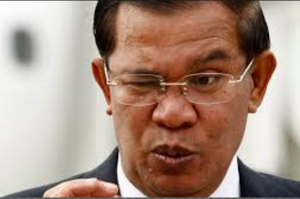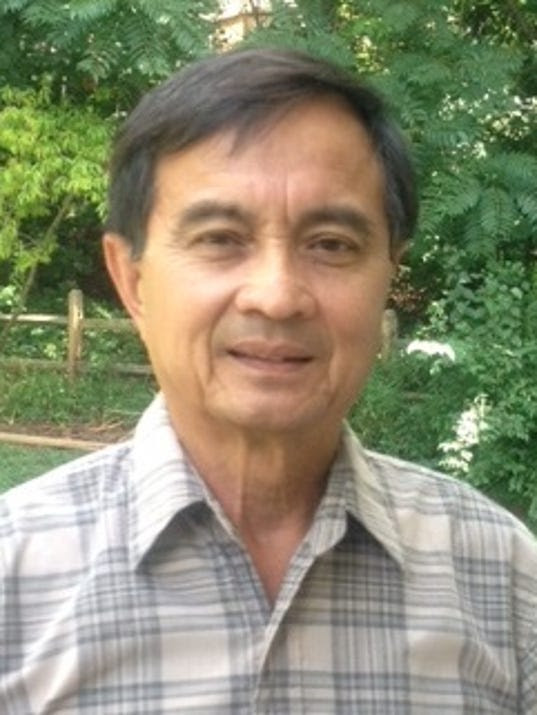«នៅពេលមនុស្សល្អនៅស្ងាត់ស្ងៀម» ទី ២
និពន្ធដោយលោកបណ្ឌិត ហ្គាហ្វារ ពាងម៉េត
http://kumnitkhmer.com/
ថ្ងៃទី១០ ខែមិថុនា ឆ្នាំ២០១៨
 លទ្ធិប្រជាធិបតេយ្យលើកតម្កើងប្រជាពលរដ្ឋជា «អធិបតី» ពោលគឺជាធំ ។ នៅក្នុងការគ្រប់ គ្រងនគរ លទ្ធិប្រជាធិបតេយ្យប្រកាន់យកឆន្ទះប្រជាពលរដ្ឋជាកំពូលនៅក្នុងសេចក្តីសំរេច នយោបាយ ឬមាគ៌ានយោបាយរបស់ប្រទេស ។
លទ្ធិប្រជាធិបតេយ្យលើកតម្កើងប្រជាពលរដ្ឋជា «អធិបតី» ពោលគឺជាធំ ។ នៅក្នុងការគ្រប់ គ្រងនគរ លទ្ធិប្រជាធិបតេយ្យប្រកាន់យកឆន្ទះប្រជាពលរដ្ឋជាកំពូលនៅក្នុងសេចក្តីសំរេច នយោបាយ ឬមាគ៌ានយោបាយរបស់ប្រទេស ។
ខ្ញុំបានរំឮកនៅក្នុងអត្ថបទខ្ញុំកាលពីមុននេះថា អង្គភាពភូមិសាស្ត្រក្រិកបុរាណឈ្មោះ Athens ជាប្រទេសទីមួយក្នុងលោកដែលបានឱបក្រសោបលទ្ធិប្រជាធិបតេយ្យតាំងតែពីក្នុងសតវត្សទី ៥ មុនគ្រឹស្ទសករាជមកម្លេះ ។ ពោលគឺពលរដ្ឋក្រិកបុរាណដែលបានប្រសូតទស្សនៈ «សេរីភាពរបស់បុគ្គលមនុស្ស» ដែលបានក្លាយទៅជាមូលដ្ឋានគ្រឹះនៃអរិយធម៌ពិភពលោកខាង លិចហើយពាក្យក្រិកមានន័យថា «ប៉ូលីទីកូស» politikos ដែលខ្មែរយើងនិយមហៅថា ប៉ូលីទីក គឺសំដៅទៅលើការទំនាក់ទំនងរវាងពលរដ្ឋក្រិកនិងអង្គភាពភូមិសាស្ត្ររបស់គេ ។ រដ្ឋ Athens ឈរនៅលើមូលដ្ឋាននៃពលរដ្ឋដែលមានសេរីភាពនិងមានការយល់ដឹងសមល្មម ហើយដែលមើលឃើញថា ការចូលរួមនៅក្នុងកិច្ចការរដ្ឋគឺជាកិត្តិយសនិងជាភារៈកិច្ចរបស់ ពលរដ្ឋ ។
នៅក្នុងគំនិតបណ្តុះបណ្តាលលទ្ធិប្រជាធិបតេយ្យឱ្យបាននៅគង់វង្ស នៅទ្វីបអឺរ៉ុប លោក ហ្ចន ឡក់ John Locke (១៦៣២-១៧០៤) ទស្សនវិទូជាតិអង់គ្លេស និងលោក ហ្សារ៍លស៍ ដឺ ម៉ុងតេសគីយើ Charles de Montesquieu (១៦៨៩-១៧៥៥ ) យុត្តិវិទូបារាំង បានផ្តោតទៅលើគំនិតបែងចែកអំណាច ឬ separation of powers; ការត្រួតពិនិត្យនិង តុល្យភាពនៃអំណាច ឬ checks and balances; និងការគ្រប់គ្រងរដ្ឋាភិបាលដោយ ប្រជាពលរដ្ឋ ឬ popular control of government ។ រីឯនៅទ្វីបអាមេរិកវិញ បិតាស្ថាបនាសហរដ្ឋអាមេរិកដែលបានសិក្សាយល់ដឹងអំពីគំនិតរបស់ទស្សវិទូអង់គ្លេសនិង យុត្តិវិទូបារាំង ក៏បានខិតខំប្រឹងប្រែងដោយឥតសំចៃកម្លាំងកាយនិងកម្លាំងប្រាជ្ញាក្នុងការបង្កើតរដ្ឋធម្មនុញ្ញមួយដើម្បីគ្រប់គ្រងប្រទេស ហើយបានដាក់ចេញនូវប្រព័ន្ធនយោបាយមួយក្នុងឆ្នាំ ១៧៨៧នៅទីក្រុងហ្វីឡាដែលហ្វីយ៉ា ដែលនៅគង់វង្សជាប់លាប់រហូតមកដល់បច្ចុប្បន្នកាលនេះ ដោយបានបញ្ចូលទៅក្នុងរដ្ឋធម្មនុញ្ញអាមេរិកាំងឆ្នាំ ១៧៨៩ នូវមូលដ្ឋានគោលការណ៍ គ្រឹះមាន ៖ «រដ្ឋាភិបាលមានកម្រិត» ឬ limited government; «ការបែងចែកអំណាច» ឬ separation of powers; «ការត្រួតពិនិត្យនិងតុល្យភាពនៃអំណាច» ឬ checks and balances; និង «ប្រព័ន្ធសហព័ន្ធ» ឬ្ federalism បែងចែកអំណាចសហពន្ធពី អំណាចខេត្ត ។ អ្វីដែល បិតាស្ថាបនាសហរដ្ឋអាមេរិកខ្លាចហើយចង់ជៀសវាងណាស់គឺរបបជិះជាន់និងឃោរឃៅ ដែលគេឱ្យឈ្មោះថា tyranny ហើយនិងអ្វីដែលគេបានឱ្យឈ្មោះថាជា «elective despotism» ឬ របបជិះជាន់តាមរយះបោះឆ្នោតជ្រើសរើស ។ លោក ហ្ចេមស៍ ម៉ាឌីសុន James Madison (១៧៥១-១៨៣៦) ដែលបានជាប់ឆ្នោតជាប្រធានាធិបតីអាមេរិកាំងទី ៤ ក្នុងឆ្នាំ ១៧៨៩ លោក អាឡិចហ្សាន់ឌ័រ ហាម៉ិលតុន Alexander Hamilton (១៧៥៧-១៨០៤) ដែលបានធ្វើ ជារដ្ឋមន្ត្រីក្រសួងហិរញ្ញវត្ថុក្នុងឆ្នាំ ១៧៨៩ ហើយនិង លោក ហ្ចន ហ្ចេយ៍ John Jay (១៧៤៥-១៨២៩) ដែលបានធ្វើជាមន្ត្រីយុត្តិធម៌ទីមួយនៃតុលាការកំពូលអាមេរិកាំងនៅឆ្នាំ ១៧៨៩ ជាបិតារដ្ឋធម្មនុញ្ញសហរដ្ឋអាមេរិក ។ លោក James Madison បានផ្តល់អត្ថន័យ ដល់ពាក្យ tyranny ដូចតទៅនេះ ៖ tyranny គឺ «ការប្រមូលផ្តុំអំណាច (គ្រប់គ្រង)ទាំងអស់ ទាំងអំណាចនីតិបញ្ញត្តិ អំណាចប្រតិបត្តិ និងអំណាចតុលាការឱ្យនៅក្នុងកណ្តាប់ដៃបុគ្គល មនុស្ស ទោះបីតែមួយនាក់ ឬបី-បួន-ប្រាំនាក់ ឬច្រើននាក់ ហើយទោះបីជាក្នុងបុព្វហេតុ តំណពូជ hereditary – តែងតាំងខ្លួនឯង self-appointed – ឬដោយវិធីជ្រើសរើស elective» ។
បិតាស្ថាបនាសហរដ្ឋអាមេរិកភ័យខ្លាចថាការផ្តុំអំណាចនឹងអាចជាន់ឈ្លីសិទ្ធិមនុស្សនិងកម្មសិទ្ធទ្រព្យសម្បតិ្តរបស់ពលរដ្ឋ ។ គេជឿថា បុគ្គលណាដែលកាន់ក្តោបអំណាចតែងតែ លំអៀងយកអំណាចនោះទៅប្រើនៅគ្រប់ទីកន្លែងផ្សេងៗតាមតែខ្លួនអាចធ្វើទៅបាន ។ ជំនឿនេះបានជម្រុញគេឱ្យបង្កើតជា «រដ្ឋាភិបាលមានកម្រិត» ឬ limited government ដោយគេបែងចែកអំណាចជាបី ៖ គឺនីតិបញ្ញត្តិ ប្រតិបត្តិ និង តុលាការ ហើយគេបង្កើត ប្រព័ន្ធ «បែងចែកអំណាច» មិនឱ្យអំណាចណាមួយអាចវាតទីឈ្លានពានទៅលើអំណាច ឯណាទៀតដែរ ពោលយ៉ាងខ្លី គឺការចែកតួនាទីនិងភារៈកិច្ចផ្សេងៗដោយសភាបង្កើតច្បាប់ រដ្ឋាភិបាលអនុវត្តច្បាប់ តុលាការធ្វើ សេចក្តីសំរេចអំពីច្បាប់ ឬកាត់សេចក្តីការរំលោភលើច្បាប់ ។ តែនេះមិនមែនបានសេចក្តីថា មានឪខ្លាត្រីកាន់អំណាចមួយៗនោះទេ ។ គេបានបង្កើតប្រព័ន្ធ checks and balances ឬ «ការត្រួតពិនិត្យនិងតុល្យភាពនៃអំណាច» មិនឱ្យមានឪខ្លាត្រីជិះសេះលែងដៃឡើយ ពោលគឺអំណាចនិមួយៗមានភារៈត្រួតពិនិត្យអំណាចផ្សេងទៀត គឺថា សភាបង្កើតច្បាប់ ក៏ប៉ុន្តែអំណាចប្រតិបត្តិអាចជំទាស់ ហើយសភាអាចប្រមូលសម្លេងពីរភាគបីទាត់ចោល ទំនាស់របស់អំណាចប្រតិបត្តិ ។ ម៉្យាងវិញទៀត អំណាចប្រតិបត្តិអាចតែងតាំងមន្ត្រីតូច ធំហើយអាចស៊ីញ៉េសន្ធិសញ្ញាក៏ប៉ុន្តែព្រឹទ្ធសភាត្រូវឱ្យឬមិនឱ្យសច្ចានុមតិ ។ អំណាច តុលាការត្រូវពិនិត្យមើលថា តើសេចក្តីសំរេចរបស់សភានិងកិច្ចអនុវត្តរបស់អំណាចប្រតិបត្តិ វាត្រឹមត្រូវស្របតាមច្បាប់រដ្ឋធម្មនុញ្ញដែលជាច្បាប់កំពូលរបស់ប្រទេសជាតិដែរឬទេ ។ ម៉្យាងវិញទៀត ចៅក្រមសហព័ន្ធសហរដ្ឋអាមេរិកត្រូវបានតែងតាំងដោយអំណាចប្រតិបត្តិ និងទទួលការយល់ព្រមពីសភាជាតិដែលមានអំណាចលើកម្លាំងធុងប្រាក់ ។ សមាជិកនៃ សភាជាអ្នកតំណាងនិងជាអ្នកទទួលឆ្នោតជ្រើសរើសដោយប្រជាពលរដ្ឋ ។ នៅទីបញ្ចប់ គឺរូបអ្នកនិងរូបខ្ញុំដែលជាប្រជាពលរដ្ឋ ។
នៅក្នុង Federalist Paper ឬ «សន្លឹកឯកសារសហព័ន្ធ» លេខ ៥១ លោក James Madison បានសរសេរថា៖ «ការការពារមួយយ៉ាងធំបំផុតកុំឱ្យមានការប្រមូលផ្តុំអំណាចបន្តិចម្តងៗ គឺត្រូវផ្តល់មធ្យោបាយដែលចាំបាច់តាមរដ្ឋធម្មនុញ្ញ . . . ដើម្បីទប់ទល់នឹងការឈ្លានពាន អំណាច . . . មហិច្ឆិតាមួយត្រូវទប់ទល់នឹងមហិច្ឆិតាមួយទៀត . . . បើមនុស្សលោកជាទេវតា មិនចាំបាច់មានរដ្ឋាភិបាលគ្រប់គ្រងទេ ហើយបើទេវតាជាអ្នកគ្រប់គ្រងមនុស្ស ក៏មិនចាំបាច់ មានការត្រួតពិនិត្យរដ្ឋាភិបាលពីក្នុងឬពីក្រៅដែរ ។ ដោយហេតុថា យើងត្រូវបង្កើតរដ្ឋាភិបាល មួយដែលមានបុគ្គលមនុស្សគ្រប់គ្រងលើបុគ្គលមនុស្ស . . . ការពឹងផ្អែងទៅលើប្រជាពលរដ្ឋ ជាការត្រួតពិនិត្យលេខមួយដោយឥតសង្ស័យទៅលើរដ្ឋាភិបាល ហើយការពិសោធន៍ក៏បាន បង្រៀនមនុស្សលោកដែរអំពីការចាំបាច់ឱ្យមានជំនួយដ៏ប្រយត្ន័ប្រយែងផងទាំងឡាយ» ។

 Am I witnessing an encore of Khmers resuming political circle dancing, the Ramvong, moving hands and feet, going around and around in a circle, setting aside their recent posture of traditional Chul Trei Krem, or Siamese (Beta) fish fighting game described in my last article?
Am I witnessing an encore of Khmers resuming political circle dancing, the Ramvong, moving hands and feet, going around and around in a circle, setting aside their recent posture of traditional Chul Trei Krem, or Siamese (Beta) fish fighting game described in my last article? 